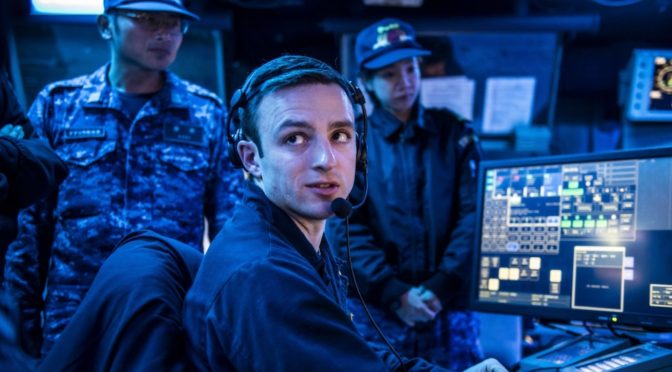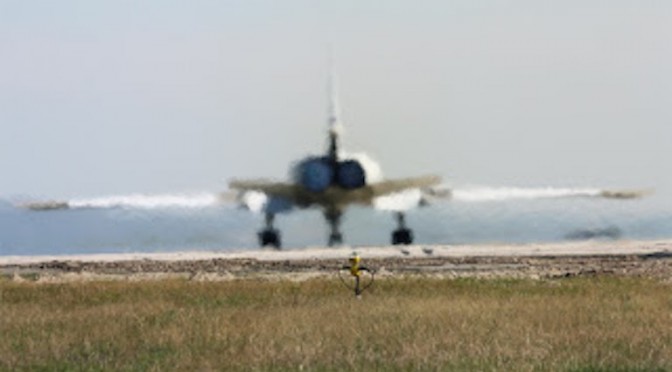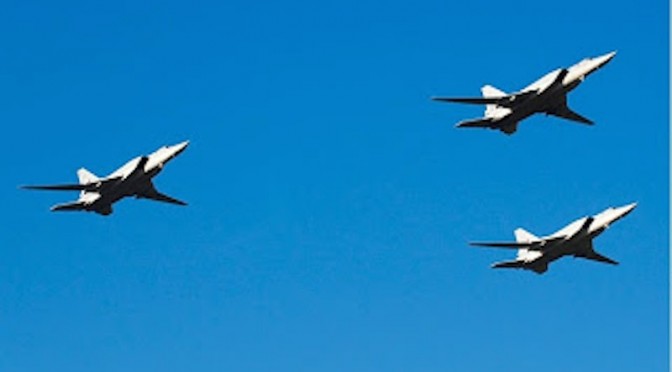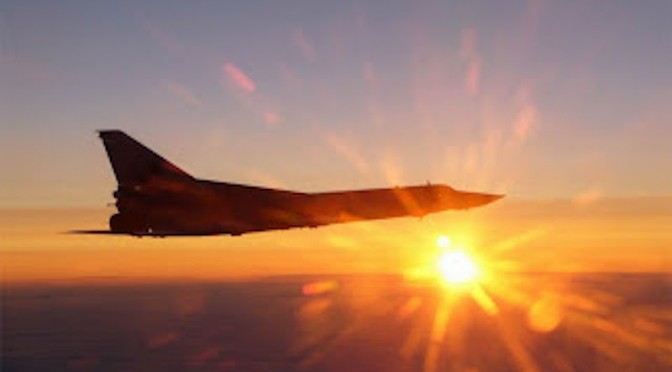The following article is adapted from a new report by the Center for Strategic and Budgetary Assessments (CSBA), Winning the Invisible War: Gaining an Enduring U.S. Advantage in the Electromagnetic Spectrum.
By Bryan Clark, Whitney M. McNamara, and Timothy A. Walton
The explosion of mobile communications and emerging Internet of Things are turning the electromagnetic spectrum (EMS) into an increasingly crowded place. The advent of 5G, which needs wide swaths of spectrum in multiple frequency ranges to achieve high data rates, will only intensify this trend and create more conflicts between commercial and government users. The challenge of spectrum management and control will be acute for militaries, which depend almost entirely on the EMS for sensing and communications.
The American military is particularly affected by a congested EMS. U.S. forces deploy the most advanced networks of sensors and precision-guided munitions, relying on them for almost all operations. Adversaries like China and Russia have exploited this dependence during the last decade by developing and fielding a comprehensive array of electronic warfare (EW) systems to contest the spectrum.
The U.S. military, however, did not address the challenge posed by its competitors and numerous assessments now argue the U.S. military is unprepared for competition or conflict in the EMS. The problem was not a lack of funding, as defense spending for EMS operations grew steadily since 2015. DoD’s EMS shortfalls arose because the additional dollars were not spent implementing a coherent strategy and instead were used to upgrade legacy systems and fill various capability gaps. Regaining EMS superiority against Chinese and Russian forces at the current pace will take one or two decades – assuming America’s adversaries do not continue to improve.
DoD should accelerate its efforts to regain an advantage in the spectrum, but likely budget constraints will preclude simply throwing more money at the problem. Instead of perpetuating the current move-countermove competition by attempting to fill every EMS capability gap, DoD can adopt a new approach to EMS operations focused on asymmetries between U.S and opposing militaries. An EMS strategy designed to undermine enemy strengths and exploit adversary vulnerabilities may leave some capability gaps intact but could be the only way for the U.S. military to achieve EMS superiority in time to forestall opportunistic aggression by one of America’s military competitors.
Exploiting Asymmetries
The most important asymmetry between U.S. and opposing militaries is the adversary’s “home team” advantage and how it impacts EMS operations. For example, Chinese and Russian forces can exploit their proximity to likely conflicts by employing sensor techniques that rely on multiple stationary arrays such as passive radio frequency (RF) detection or geolocation and long-range high frequency radars. As an expeditionary force, the U.S. military is less able to employ these techniques and often relies on active, monostatic radars for situational awareness and defense, exposing U.S. units to enemy detection and geolocation.
Their home team advantage also allows China’s People’s Liberation Army (PLA) and the Russian Armed Forces to place EW and sensor systems on their own territory, where they can rely on wired communications, or in nearby sea or airspace, where line-of-sight RF communications can be reliable and difficult to jam. The relatively uncluttered spectrum near their territory also permits Chinese and Russian militaries to pre-plan their spectrum use. As an expeditionary force, the U.S. military must manage spectrum dynamically.
The proximity of U.S. competitors to likely areas of conflict creates additional asymmetries in force design and command and control (C2) between U.S. and competing militaries. For example, because the PLA understands where conflict is likely to occur, the Chinese forces to be employed, and the likely variety of enemy dispositions and tactics, the PLA can employ pre-architected systems of systems and tactics. This approach, which Chinese military strategists call System Destruction Warfare, prioritizes attacks on perceived enemy vulnerabilities, such as U.S. forces’ dependence on the EMS. Although it also uses pre-architected systems and focuses contesting adversary information operations, the Russian military’s C2 approach delegates subordinates more authority to improvise tactics. Similar to PLA leaders, however, Russian commanders are expected to use modeling and cybernetics to scientifically lead forces and anticipate combat outcomes.
The worldwide commitments of the U.S. military require a more expeditionary and self-contained force design than those needed by Chinese or Russia forces. Today, U.S. forces center on large multimission platforms and troop formations, which are efficient but constrain the force’s flexibility. U.S. forces also need a more adaptable C2 process than the Chinese or Russian militaries to accommodate more contested communications, changing force packages, and the variety of local conditions. The U.S. military employs “mission command” to rely on a junior leader’s judgment and ability to follow the commander’s intent if communications are lost. A lack of planning and management tools available to junior commanders currently hinders their ability to innovate, however, making their actions more predictable to an adversary.
A Return to Maneuver Warfare
To regain EMS superiority, DoD should focus on exploiting asymmetries in ways that could undermine adversary strengths or exploit enemy vulnerabilities. Most prominently, the home team advantage of U.S. adversaries could be turned into a weakness if DoD adopts new warfighting approaches that emphasize maneuver and complexity. For instance, the PLA’s reliance on pre-planned, static systems of systems and tactics could be a disadvantage against highly dynamic and unpredictable U.S. force postures and capabilities. Furthermore, complex U.S. operations in the EMS could be especially effective against Chinese and Russian operational concepts that center on defeating U.S. C2, communications, and sensors.
To fully exploit the potential of maneuver warfare, the U.S. military should replace some of its self-contained multimission units that result in highly predictable force packages and tactics with cheaper and less multifunctional units to create a disaggregated and recomposable force. This would enable greater adaptability in U.S. force packages while imposing considerable complexity on adversaries. A disaggregated force would better enable the U.S. military to conduct EMS operations that would be challenging for an enemy to detect and counter, including passive and multistatic sensing, distributed EW, and decoy operations.
A disaggregated force will be difficult to manage, however, in a contested communications environment. Instead of DoD’s current trend toward centralized staffs and resilient wide-area communications for distributed operations, the U.S. military should address this challenge by adopting context-centric C2 and communications (C3). In this approach, C2 relationships are based on communications availability, rather trying to build a communications architecture to support a pre-determined C2 hierarchy. An essential element of context-centric C3 is planning tools that enable junior leaders at to creatively plan, adapt, and recompose their forces and operations. These tools are already being developed and fielded by DoD labs and industry.
U.S. forces will also need to dramatically change how they operate in the EMS to impose complexity and uncertainty on an adversary. Most importantly, the U.S. military’s over-reliance on active monostatic radars can enable adversaries to understand U.S. dispositions and tactics because radars can be detected, classified, and geolocated relatively easily. To more fully support maneuver and adaptability, U.S. forces should use more passive or multistatic sensing, complemented by LPI/LPD communications and electronic countermeasures.
To support passive and multistatic sensing, every U.S. EMS system should also incorporate passive RF detection, or electronic support (ES), functionality. ES capabilities would also help achieve LPI/LPD characteristics by monitoring friendly emissions; improve the effectiveness of EW actions by sensing adversary EMS actions; and enable coordination of EMS operations with minimal communications by detecting EMS operations of collaborating units. Introducing multifunction EMS systems to U.S. forces that can communicate, sense, jam, and decoy, would increase the variety of locations from which sensing or effects be delivered and provide greater adaptability to U.S. forces.
Fully exploiting networked and multifunction capabilities to operate at machine speed will require operators to yield some decision-making to the EMSO system. Today, adaptive algorithms that can react to adversary actions are reaching EW systems in operating forces. These programs should be accelerated, along with efforts to establish testing processes and data governance procedures for future cognitive EMS systems. The most significant impediments to networked EMSO and EMBM are creating interoperable data transmission standards and the varied security levels at which different EMSO systems operate.
EMS maneuver and superiority only have meaning if DoD treats the EMS as an operational domain. Today’s approach to EMS operations treats the EMS as a utility, in which actions such as electronic attack (EA), ES, electronic protection (EP), communications, and sensing are distinct operations. In a domain construct, these actions would be considered as interrelated operations that can be employed in concert to accomplish the commander’s intent and tasking through maneuver in the EMS.
Implementing a New EMS strategy
A more disaggregated and recomposable force has significant implications for how DoD identifies and develops new capabilities. For example, requirements will be harder to determine if the configuration of force packages is not known in advance. Therefore, DoD could adopt an opportunity-based, rather than requirements-based, approach to capability development. New systems would be assessed based on their ability to improve mission outcomes in a range of scenarios and force packages, rather than engineering a point solution based on assumptions regarding future forces and operations. DoD’s new Middle Tier Acquisition Process reflects this approach.
One tool for assessing the potential benefits of new technologies or systems is experimentation. DoD’s EMS training ranges are unable to provide realistic modern operational environments, but operational security concerns would prevent U.S. forces from recouping the significant investment needed to upgrading live open-air facilities. DoD should shift its emphasis for EMS operations training to virtual and constructive facilities, which would enable concept development, tactics innovation, and training against the most challenging threats at all security levels. Live EMS training to practice safe operations could focus on less-modern threats or employ closed-loop radar, communication, and EW systems.
An Imperative to Change
DoD cannot continue attempting to gain EMS superiority by incrementally filling capability gaps. This approach is too unfocused, will take too long to reach fruition, is potentially unaffordable, and cedes the initiative to America’s great power competitors. Instead of reacting to adversary moves with its own countermoves, DoD should move in a new direction and focus EW and EMSO capability development on implementing concepts for maneuver warfare that create adaptability for U.S. forces and complexity for adversaries.
If the DoD does not mount a new more strategic and proactive approach to fighting in the EMS and developing the requisite capabilities, adversaries could be emboldened to continue their efforts to gain territory and influence at the expense of U.S. allies and partners. Demonstrating the ability to survive and fight in a contested EMS could help U.S. forces slow Chinese and Russian activities and deter or dissuade these adversaries from more aggressive approaches to their objectives.
Bryan Clark is a Senior Fellow at CSBA.
Timothy Walton is a Research Fellow at CSBA.
Whitney M. McNamara is a Senior Analyst at CSBA.
Featured Image: PHILIPPINE SEA (Nov. 13, 2019) Lt. j. g. Louis Wohletz, from Minneapolis, center, is observed by Japan Maritime Self-Defense Force officers as he stands watch as a surface warfare coordinator during a maritime strike operation exercise in the combat information center of the Arleigh Burke-class guided-missile destroyer USS Milius (DDG 69) during Annual Exercise (ANNUALEX) 19. (U.S. Navy photo by Mass Communication Specialist 2nd Class Taylor DiMartino)




